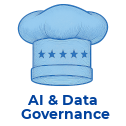For the past few weeks we have been exploring three failure patterns many governance programs experience (#4 headed your way next week). Most of these patterns can be avoided by establishing a well thought out governance charter up front as you launch your program.
If you never established a charter, no worries, just follow the steps outlined in the book 5 Star AI & Data Governance (get your copy HERE).
Let’s discuss some of the ideas from Chapter 5: Your Governance Charter, The Master Recipe Book.
“A great chef doesn’t just cook by instinct, they have a master recipe book that captures best practices and ensures consistency. Responsible AI teams don’t just build models by intuition; they have governance charters that ensure ethical, explainable, and trustworthy AI deployment.”
Think of your governance charter as the master recipe book in a world-class kitchen. It doesn’t contain every possible recipe, but it captures the essential principles, proven methods, and quality standards that ensure every dish meets the restaurant’s reputation for excellence.
What are the essential ingredients of a governance charter?
- Mission and Vision: What is your team trying to achieve and why?
- Scope and Boundaries: What is included and excluded from your governance mandate?
- Roles and Responsibilities: Who does what and who makes which decisions?
- Decision-Making Framework: How will decisions be made and communicated?
- Communication Protocol: How will the team communicate internally and externally?
- Success Metrics: How will you measure progress and success?
- Operating Principles: What values and behaviors guide your team?
Beware of this charter trap: Documents that Become Doorstops. It happens when your governance charter is designed by committee, written like legal documents, and read by no one.
The problem with too many governance charters is that they’re written for the wrong audience.
They’re designed to impress executives and satisfy compliance requirements rather than guide daily decision-making and behavior change.
Great recipe books share common characteristics:
- Clear Purpose: Every recipe solves a specific problem or creates a desired outcome
- Simple Instructions: Steps are clear, actionable, and easy to follow
- Flexible Framework: Principles that can be adapted to different situations
- Practical Focus: Emphasis on results, not process compliance
- User-Friendly: Written for the people who will actually use it
Your governance charter should work the same way. It should be a practical guide that people actually reference when they need to make data-related decisions.
Here is a short case study of a successfully written governance charter:
A Governance Charter Evolution
The task was to establish a governance program for a world class, global manufacturing company. It started with a 6-page document that focused on unlocking business value through trusted, accessible, and actionable data. Here’s how it was structured:
Vision (1 page): Clear explanation of the strategic objectives: driving business growth, operational excellence, risk mitigation, innovation enablement and stakeholder trust.
Scope (1 page): Clear definition of domain scope (customer, supplier and product), geography (global) and data lifecycle coverage.
Role Clarification (1 page): Outlined responsibilities for Executives, Governance Councils, Data Stewards, Data Custodians and Business Data Users.
Principles (2 pages): Five operating principles: business-first approach, data quality excellence, collaboration and transparency, security/compliance and continuous improvement.
Success Metrics (1 page): Metrics for business impact and operational excellence.
The charter was practical, actionable, and actually referenced by team members when making decisions. More importantly, it evolved based on the team’s experience and results.

